Ukrainian Railways
State-owned railway company in Ukraine From Wikipedia, the free encyclopedia
The Public JSC Ukrainian Railways or PAT 'Ukrzaliznytsia (UZ)' (Ukrainian: ПАТ "Укрзалізниця (УЗ)") is a state-owned joint-stock company administering railway infrastructure and rail transport in Ukraine; a monopoly that controls the vast majority of the railroad transportation in the country.[a] Ukrainian Railways is the world's sixth largest rail passenger transporter and world's seventh largest freight transporter. As of 2020, the total length of the main broad-gauge (1,520 mm (4 ft 11+27⁄32 in)) railroad network was 19,787 kilometres (12,295 mi),[5] making it the 13th largest in the world. Ukraine also has many stretches of standard-gauge railway (1,435 mm), and is currently working to expand these in order to improve its connections to the European Union.[6]
This article needs to be updated. (October 2022) |
 | |
| Company type | Public joint-stock company |
|---|---|
| Industry | Railway transportation, Railway infrastructure, intermodal freight transport |
| Founded | 1991 |
| Headquarters | 5 Jerzy Giedroyc Street, Kyiv, Ukraine, 03680 [1] |
Number of locations | 1,700 stations and halts |
Area served | Ukraine |
Key people | Oleksandr Pertsovskyi (CEO) [2] |
| Products | Rail transport services (passenger & cargo) |
| Revenue | ₴20.06 billion (2017)[3] |
| ₴203.8 million (2018)[4] | |
| Owner | Government of Ukraine (100%) |
Number of employees | 191,700 (2023) |
| Parent | Ministry of Infrastructure |
| Divisions | 6 branches (Kyiv, Donetsk, Lviv, Odesa, Kharkiv, Dnipro) |
| Website | Official website |
In 2015, Ukrainian Railways was transformed through a merger of a state agency and a state-owned enterprise into a public joint stock company owned by the state. Ukraine's State Administration of Railroad Transportation is subordinated to the Ministry of Infrastructure,[b] administering the railways through the six territorial railway companies that immediately control and provide of all aspects of the railroad transportation and maintenance under the common Ukrzaliznytsia brand. The general director of the administration is appointed by the Cabinet of Ministers of Ukraine.[7] The company employs more than 191,700 people throughout the country.[8]
During the 2022 Russian invasion of Ukraine, Ukrainian Railways continued operating to evacuate and rescue millions of people from cities out of the country. The rail links between Ukraine and Russia have been blown up by the Armed Forces of Ukraine to prevent their use by Russians, but the railways have continued operating within Ukraine and between Ukraine and Poland, Hungary, Republic of Moldova, and Slovakia. One long-abandoned cross-border rail link with Poland was quickly reconstructed, and others which had been used only for freight have been quickly opened for passenger use.[9] The rail service has evacuated[10] over two million people from Ukraine on special evacuation trains. After some of the Black Sea ports became unavailable for grain export, rail became an export route to the rest of Europe. Several rail sections in the North and South became unusable.[11]
Company structure
Summarize
Perspective
Financial history
In 2017, Ukrainian Railways (Ukrzaliznytsia) was the fourth-most profitable company in Ukraine with a revenue of ₴74 billion.[12]
In 2019, Ukrainian Railways confirmed intention to issue new Eurobond. Ukrainian Railways had the potential to increase its debt by US$1 billion, indicating a possible Eurobond issue. Recall, Ukrainian Railway's existing US$500 million Eurobond will be amortized by US$150M both in March and September 2019 and then by US$50 million semi-annually between March 2020 and September 2021. He also confirmed that Ukrainian Railway is now considering a Eurobond issue, on which he can further comment as soon as the government publishes a respective resolution (on its parameters). Kravtsov also highlighted that it's important for investors to have a clear understanding on how the borrowing will be serviced. Taking this into account, Ukrainian Railways has proposed a mechanism of automatic adjustment of freight railway rates based on Ukraine's producer price index.[13]
Administrative structure

The railways are split into six territorial railway companies: Donetsk, Lviv, Odesa, Southern, South-Western and Cisdnieper. The subdivision is purely administrative as it doesn't correspond to the particular railway lines or branches. The names of regional railways are purely historic, inherited from the Russian and Austro-Hungarian Empires (for instance the 'South-Western Railway' actually operates the north-central part of Ukraine's rail network, while the 'Southern Railway' actually operates in the east of the country).[14]
The six separate territorial railways each have their own directorates, located in the following cities:[citation needed]
- Donetsk Railway – Lyman (temporary directorate, as Donetsk is controlled by the Russian military)
- Lviv Railway – Lviv
- Odesa Railway – Odesa
- Southern Railway – Kharkiv
- Southwestern Railway – Kyiv
- Cisdnieper Railway – Dnipro
Since 2014, the Cisdnieper Division of Crimean Railways is no longer under Ukrainian control.[citation needed]
In February 2025, the Commission of the Ukrainian Institute of National Memory Noted that "Southwestern" and "Southern Railways" names are propaganda for Russian imperial policy and violate the law.[15][16]
Company reform
Ukrainian Railways suffer from a variety of issues mostly inherited from Soviet times. The reforms aim to address these issues in order to improve quality of service, transparency and governance.[citation needed]
Enactment of the law "On Railway Transport of Ukraine"
The law seeks to harmonize Ukrainian rail-related legislation with European Union law. It sets out the basic requirements, responsibilities and rights of the infrastructure operator, the carrier and the owners of access tracks, rules for infrastructure management, basic requirements for railway rolling stock, and basic activities of railway rolling stock operators. The bill also provides for the creation of a system of public administration in the field of railway safety in accordance with the requirements of European Union legislation, the implementation of which is provided by the Association Agreement, which will increase transport safety in conditions of competition in the railway market. According to the Ministry of Infrastructure of Ukraine, the law, supported by European experts, serves as a starting point for real reforms in the industry.[17]
Structural reform of Ukrainian Railways JSC
The company is to be separated into verticals in accordance with modern practices. This involves the creation of separate freight, passenger, production and infrastructure operators within Ukrainian Railways by the end of 2021.[18] According to the Ministry of Infrastructure of Ukraine, the project will ensure the transparency of financial flows within the company, and improve the quality of management of each activity. This will allow Ukrainian Railways to prepare for the emergence of private competitors in the railway market.[17]
Subsidiaries and partners
Ukrainian Railways owns or cooperates with several rail and train companies.
Infrastructure
Railways in Ukraine use various gauge types. The broad gauge (1,520 mm), a legacy of Imperial Russian and Soviet times, dominates the landscape, and narrow-gauge railways (750 mm) also exist, but plans are being made to construct, restore or switch to more standard-gauge railways (1,435 mm) for better train connections with the rest of Europe.[19] About half of railways in Ukraine are electrified (some of which have been damaged during the ongoing Russo-Ukrainian War and temporarily switched to diesel trains).[20]
The total length of Ukrainian rails of all gauges was 28,000 kilometres at the end of 1997.[21] Around January 2022, the length of railways in Ukraine was 19,790 km in broad-gauge 1520 mm (excluding those located in temporarily occupied territory), about 350 km in standard-gauge 1435 mm, and about 400 km in narrow gauge 750 mm.
[21]Rolling stock
Summarize
Perspective


Ukrzaliznytsia has several repair factories capable of producing locomotives and railcars. In addition there is a separate Kryukiv Railcar Engineering Factory and Dnieper Railcar Engineering that also produce railroad rolling stock for Ukrzaliznytsia and other companies for public transportation.
In November 2010, UZ agreed to buy 10 high-speed HRCS2 multiple unit interurban trainsets from Hyundai Rotem, with the prospect of a much larger order or joint venture for local production.[22] The first two trains would be delivered in February 2012, two more in April and another two in May, when they will start operating.[23][needs update] They will be rated as Inter City+ and will be connecting Kyiv with Kharkiv, Donetsk and Lviv, and at a later stage with Dnipro and Odesa.[24][needs update]
In July 2011 UZ announced plans to buy 433 electric freight locomotives; 292 2EL4s from Transmashholding, and 141 locomotives (including class VL11M/6) from Elmavalmshenebeli (Tbilisi).[25] Due to the 2014 Russian invasion of Ukraine Transmashholding was put on a sanctions list.[26]
In December 2017, UZ and GE Transportation agreed a to strategic partnership for the implementation of a 7-year rolling stock renewal program including the delivery of 30 locomotives to Ukrzaliznytsia in September 2018 with 40% manufactured in Ukraine.[27]
Locomotives
| Image | Class | Type | Number | Manufacturer | Constructed | Notes |
|---|---|---|---|---|---|---|
 |
2EL4 | 3 KV DC electric locomotive | 6 | Luhanskteplovoz | 2009-2013 | DC version of 2EL5 |
 |
2EL5 | 25 kV AC electric locomotive | 20 | Luhanskteplovoz | 2005- | AC version of 2EL4 |
 |
2ES5K | 25 kV AC electric locomotive | 15 | Novocherkassk Electric Locomotive Plant | 2004 | |
 |
ChS2 | 3 kV DC electric locomotive | 111 | Škoda Works | 1958-1976 | |
 |
ChS4 | 25kV AC electric locomotive | 150 | Škoda Works | 1963-1972 | |
 |
ChS7 | 3 kV DC electric locomotive | 27 | Škoda Works | 1983-1989 | |
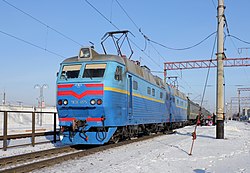 |
ChS8 | 25 kV AC electric locomotive | 36 | Škoda Works | 1983–89 | |
 |
DE1 | 3 kV DC electric locomotive | 40 | NPO DEVZ | 1997–2008 | |
 |
DS3 | 25 kV AC electric locomotive | 16 | GP NPK | 2003–08 | |
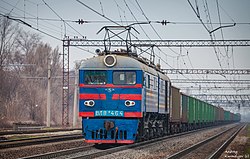 |
VL8 | 3 kV DC electric locomotive | ~200 | Novocherkassk Electric Locomotive Plant | 1953–67 | Several destroyed in the 2022 Russian invasion of Ukraine[28] |
 |
VL10 | 3 kV DC electric locomotive | ~240 | Novocherkassk Electric Locomotive Plant | 1961–1989 | |
 |
VL11 | 3 kV DC electric locomotive | 112 | Tbilisi electric locomotive builder plant | 1975-1978 | |
 |
VL40U | 25 kV AC electric locomotive | 6 | Zaporizhzhia Electric Locomotive Plant | 2004 | Double ended, single unit version of VL80 |
 |
VL60 | 25 kV AC electric locomotive | Novocherkassk Electric Locomotive Plant | 1957-1967 | ||
 |
VL80 | 25 kV AC electric locomotive | Novocherkassk Electric Locomotive Plant | 1961-1995 | ||
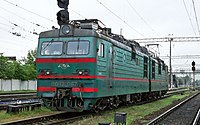 |
VL82 | 3 kV DC + 25 kV AC electric locomotive | Novocherkassk Electric Locomotive Plant | 1966-1979 | Dual voltage version of VL80 | |
 |
2TE116 | Diesel-electric locomotive | Luhanskteplovoz | 1971-2015 | Twin units, sometimes operated as single units | |
 |
2ТЕ121 | Diesel-electric locomotive | 76 | Luhanskteplovoz | 1978-1992 | |
 |
M62 | Diesel-electric locomotive | Luhanskteplovoz | 1965-1990 | ||
 |
2M62 | Diesel-electric locomotive | Luhanskteplovoz | 1976-1990 | Twin unit version of M62 | |
 |
TEP70 | Diesel-electric locomotive | Kolomna Locomotive Works | 1973 | ||
 |
TEP150 | Diesel-electric locomotive | 4 | Luhanskteplovoz | 2005 | |
 |
TE33A | Diesel-electric locomotive | 70 | General Electric Transportation/JSC Lokomotiv | 2019- | |
 |
ChME3 | Diesel-electric shunting locomotive | ČKD | 1963-1994 | ||
 |
TEM2 | Diesel-electric shunting locomotive | Bryansk and Luhansk Locomotive Works | 1967–1987 | ||
 |
TEM18 | Diesel-electric shunting locomotive | Bryansk and Luhansk Locomotive Works | 1992- | ||
 |
TEM103 | Diesel-electric shunting locomotive | 1 | Electrotyazhmash | 2005 | |
 |
TGK2 | Diesel-hydraulic shunting locomotive | Kaluga Machine Building Plant | 1960-2008 | Preserved example pictured | |
 |
TGM4B | Diesel-hydraulic shunting locomotive | Lyudinovsky Locomotive Plant | 1971-1989 | ||
 |
TGM6 | Diesel-hydraulic shunting locomotive | Lyudinovsky Diesel Locomotive Plant | 1966- | ||
 |
TGM23 | Diesel-hydraulic shunting locomotive | Murom Diesel Locomotive Plant | 1960- | ||
 |
TU2 | Diesel-electric locomotive | 6 | Kaluga Machine Building Plant | 1955-1959 | 750 mm gauge. Used on narrow gauge lines. |
 |
TU7 | Diesel-hydraulic locomotive | 1 | Kambarka Engineering Works | 1971 | 750 mm gauge. Used on Antonivka narrow gauge line. |
 |
ER | Steam locomotive | 2 | Zegelsky Locomotive Works/Reșița Works | 1951 | Used for tourist excursion services |
 |
L | Steam locomotive | 1 | Luhanskteplovoz | 1953 | Used for tourist excursion services |
 |
SU | Steam locomotive | 1 | Krasnoye Sormovo Factory | 1949 | Used for tourist excursion services |
 |
GR | Steam locomotive | 1 | Lokomotivbau Karl Marx Babelsberg | 1951 | 750 mm gauge. Used for tourist services on Antonivka narrow gauge line. |
Multiple units, railcars and diesel trains
| Image | Class | Type | Number | Manufacturer | Constructed | Service |
|---|---|---|---|---|---|---|
 |
Hyundai Rotem HRCS2 | 3kV DC/25 kV AC electric multiple unit | 10 | Hyundai Rotem | 2011–2012 | Intercity+ |
 |
EKr-1 | 3kV DC/25 kV AC electric multiple unit | 2 | Kryukiv Carriage Works | 2011–2012 | Intercity+ |
 |
Skoda EJ 675 | 3 kV DC/25 kV AC electric multiple unit | 2 | Škoda Transportation | 2011–2012 | Intercity+ |
 |
ED2T | 3 kV DC electric multiple unit | 3 | Demikhovo | 1998 | Regional |
 |
ED4M | 3 kV DC electric multiple unit | 1 | Demikhovo | 2011 | Regional |
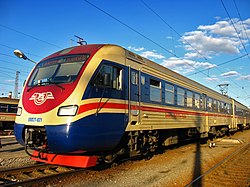 |
EPL2T | 3 kV DC electric multiple unit | 63 | Luhanskteplovoz | 2000-2008 | Suburban |
 |
EPL9T | 25 kV AC electric multiple unit | 77 | Luhanskteplovoz | 2001-2008 | Suburban |
 |
ER1 | 3 kV DC electric multiple unit | Rīgas Vagonbūves Rūpnīca | 1957-1962 | Suburban / Regional | |
 |
ER2 | 3 kV DC electric multiple unit | 250+ | Rīgas Vagonbūves Rūpnīca | 1987-1996, 2000, 2003 | Suburban / Regional |
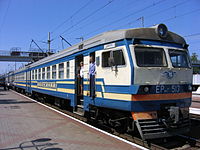 |
ER9 | 25 kV AC electric multiple unit | Rīgas Vagonbūves Rūpnīca | 1962-1964 | Suburban / Regional | |
 |
ET2 | 3 kV DC electric multiple unit | 1 | Kryukiv Carriage Works | 1995 | Pivdena Railway |
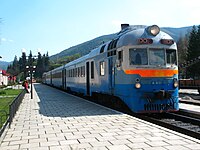 |
D1 | Diesel multiple unit | 40+ | Ganz Works | 1964-1988 | Suburban / Regional |
 |
DR1 | Diesel multiple unit | Rīgas Vagonbūves Rūpnīca | 1963-2011 | Suburban / Regional | |
 |
DEL-02 | Diesel multiple unit | 6 | Luhanskteplovoz | 2003-2012 | Regional |
 |
DPKr-2 | Diesel multiple unit | 1 | Kryukiv Railway Car Building Works | 2014 | Regional |
 |
DPKr-3 | Diesel multiple unit | 6[29] | Kryukiv Railway Car Building Works | 2019, 2021 | Regional |
 |
DPL1 | Diesel train | 6 | Luhanskteplovoz | 2007 | Regional. Formed by half a 2M62 twin diesel locomotive and 2-4 carriages from a EPL2T or EPL9T electric train |
 |
DPL2 | Diesel train | 6 | Luhanskteplovoz | 2001–2002 | Regional. Formed by half a 2TE116 twin diesel locomotive and 4 carriages in fixed formation |
 |
RA2 | Diesel multiple unit | 1 | Metrowagonmash | 2007 | Regional |
 |
Pesa 610m | Diesel multiple unit | 1 | Pesa Bydgoszcz | 2004 | Track inspection Used as a mobile command center following the 2022 Russian invasion of Ukraine.[30] |
 |
Pesa 620m | Diesel multiple unit | 11 | Pesa Bydgoszcz | 2004–2013 | Regional / Kyiv Boryspil Express |
 |
Pesa 630m | Diesel multiple unit | 2 | Pesa Bydgoszcz | 2013 | Regional |
 |
АS1А | Diesel railcar | Velykyluk Locomotive Repair Plant | 1964-1980 | Maintenance and track inspection | |
 |
AChO | Diesel railcar | 1 | Škoda Transportation | 1977-1978 | Track inspection. A second unit is stored. |
Rolling stock renewal
Passenger cars
The draft state budget for 2021 includes the purchasing of 100 new passenger cars from the Kryukiv Railway Car Building Works.[31] In 2021 Ukrzaliznytsia will also launch its first disabled-friendly trains with dedicated wheelchair space.[32]
Locomotives
In 2018 Ukrainian Railways purchased 30 General Electric TE33AC Trident freight diesel locomotives.[33] The 30 locomotives were planned to be the first stage of wider cooperation, including a 15-year partnership, and the replacement and modernization of additional Ukrainian rolling stock.[34] Later in 2020, Ukrainian Railways CEO Volodymyr Zhmak stated that he does not see the need for further GE diesel locomotives, as the company will focus on electric traction due to its higher efficiency.[35]
Following the appointment of Volodymyr Zhmak as CEO, ₴400 million was reallocated within the company for urgent locomotive repairs until the end of 2020.[36] As a part of this measure, the Lviv Locomotive Repair Plant has already received an order for the repair of 6 electric locomotives until the end of 2020.[37]
In 2021, ₴4.7 billion is planned to be spent on repairing the existing locomotive fleet.[36]
As of 2020, Alstom is interested in the renewal of the Ukrainian Railways locomotive fleet through partial localization of production. Volodymyr Zhmak stated that Ukrainian Railways is initially interested in the purchase of 50 two-system electric freight locomotives.[38] The purchase of Alstom locomotives would be financed by the French government.[39]
Statistics
Key figures as of 2020:[5]
- Main track (1,520 mm) running length: 19,787 km[5]
- Electrified track: 9,319 km[5]
- Number of railway stations: 1,402[5]
- Number of freight (goods) wagons: 85,200[5]
- Number of passenger cars: 3,883 (in active operation - 2,681)[40]
- Number of locomotives: 1,944[5]
- Average number of employees: 266,300 people[5]
- Passengers carried (2019): 149.6 million[5]
- Cargo transportation (2019): 312.4 million tonnes[5]
Classification of passenger trains (railway lines)
Summarize
Perspective

On 27 April 2011 in accordance with order No. 504/2011 rail industry specialists developed a new classification system of passenger trains for Ukrainian Railways.[41]

The development of a new classification system for passenger trains in Ukraine was made necessary by the need to inform customers (passengers) about the level of service quality they could expect to find in various passenger trains. The new system is based on the class of train and carriages.[citation needed]
Given the quality of the service provided UZ asked the following classes of passenger trains:
- Daytime passenger lines:
- Euro City (EC) – Express (min. 90 km/h) daytime services on international routes which should offer a very high level of service and comfort. First and standard classes.
- Inter City+ (IC+) – Express (min. 90 km/h) daytime services on domestic routes which should offer a very high level of service and comfort. First and standard classes. These services are currently operated by Hyundai Rotem HRCS2 multiple unit trains on routes between Kyiv and Kharkiv, Lviv, Dnipro, Zaporizhzhia, Pokrovsk, Kryvyi Rih, Kostiantynivka, Odesa, Ternopil, Kropyvnytskyi. Besides, there is one international express Kyiv - Przemyśl (Poland).[42]
- Inter City (IC) – (max. 70 km/h – 90 km/h) daytime services on domestic routes which should offer a heightened level of service and comfort. First, standard and economy classes. These services are currently operated by Škoda UZ class 675 trains on routes between Kharkiv, Dnipro and Donetsk.[needs update]
- Regional Express (РЕ) – (max. 70 km/h – 90 km/h) daytime services on domestic routes which should offer a standard level of service and comfort. First, standard and economy classes.
- Regional train (РП) – (max. 70 km/h) daytime services on domestic routes which should offer a standard level of service and comfort. Standard and economy classes.
- Nighttime passenger trains:
- Euro Night (EN) – Express (min. 90 km/h) nighttime services on international routes which should offer a very high level of service and comfort. 2 berth coupe and 4 berth coupe classes.
- Night Express (НЕ) (max. 70 km/h – 90 km/h) nighttime services on international and domestic routes which should offer a heightened level of service and comfort. 2 berth coupe, 4 berth coupe and platskarta classes.
- Night fast (НШ) – (max. 50 km/h – 70 km/h) nighttime services on international and domestic routes which should offer a heightened level of service and comfort. 2 berth coupe, 4 berth coupe and platskarta classes.
- Night passenger (НП) (max. 50 km/h) nighttime services on international and domestic routes which should offer a heightened level of service and comfort. 4 berth coupe and platskarta classes.[citation needed]
The advantages of the new classification system include full compliance with the classification of the European Union, compliance with Ukrainian and English names and abbreviations, linguistic and semantic consistency and clarity for customers in Ukraine and compatibility with existing and future tariff policy. The system is also not far displaced from the previous classification system used for passenger trains on the territory of Ukraine.[citation needed]
Education
The National Railway University in Dnipro currently has 10 faculties as well as a technical school, a business school and branches in Odesa and Lviv, 450 professors and 39 separate fields of study related to railway transport.[citation needed]
Directors


President
- 1991–1993 Borys Oliynyk
- General director
- 1993–1997 Leonid Zheleznyak
- 1997–2000 Anatoliy Slobodyan
- 2000–2004 Heorhiy Kirpa
- 2005–2005 Volodymyr Korniyenko
- 2005–2005 Zenko Aftanaziv
- 2005–2006 Vasyl Hladkikh
- 2006–2007 Volodymyr Kozak
- 2007–2007 Petro Naumenko
- 2007–2008 Vasyl Melnychuk
- 2008–2011 Mykhailo Kostiuk
- 2011–2012 Volodymyr Kozak
- 2013–2014 Serhiy Bolobolin
- 2014–2014 Borys Ostapyuk
- 2014–2015 Maksym Blank (acting)
- 2015–2015 Oleksandr Zavhorodniy (acting)
Board director
- 2015–2016 Oleksandr Zavhorodniy (acting)
- 2016–2016 Yevhen Kravtsov (acting)
- 2016–2016 Vitaliy Zhurakovskyi (acting)
- 2016–2017 Wojciech Balczun[43][44]
- 2017–2020 Yevhen Kravtsov (acting)[44][45]
- 2020 Marček Zhelko (acting)[45][46]
- 2020 Ivan Yuryk (acting)[46]
- 2020–2021 Volodymyr Zhmak[47]
- 2021–2023 Oleksandr Kamyshin[48][49]
- 2023–November 2024 Yevhen Liashchenko[50]
o Yuzef Leonidovych Tuley (Authority: to act in the name of the legal entity, including signing of the agreements etc., (until 31 March 2025)) – representative
See also
Notes
- Except for intra-company industrial railways, local military railways and municipal Metro systems.
- Previously, before December 2010 cabinet reform – to the Ministry of Transportation and Communication.
References
Bibliography
External links
Wikiwand - on
Seamless Wikipedia browsing. On steroids.
